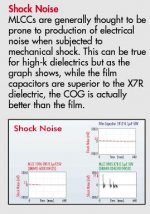Been looking for information about microphonic tendencies of COG ceramic caps, but haven't been able to find much. Bateman's "Capacitor Sound" series didn't even mention microphonics. Although I have found a little bit of info stating that COG is better than other ceramics in this regard, I haven't been able to find out just how microphonic they are, especially compared with silver mica or other caps. Since they seem to be the perfect capacitor, otherwise, especially for such applications as lag compensation, etc., the degree of microphonics appears to be the only potentially bad trait that would keep me from using them. Anyone know of good info regarding COGs and microphonics?
pooge said:Since they seem to be the perfect capacitor, otherwise, especially for such applications as lag compensation, etc., the degree of microphonics appears to be the only potentially bad trait that would keep me from using them.
Why don't you just try 'em and see how you like 'em instead of worrying about objective specs?
se
I doubt that subjectively liking them or not really applies to a lag compensation cap. That is more of a stability issue. I think that's a area better left for objective interpretation.
I understand that even COG ceramics have a fairly high dielectric constant of around 7 or so - higher than micas. That puts me off right there.
Linear tech has an example of >1mV of noise from a ceramic cap in response to tapping it with a pencil. A storage scope with a high-sensitivity input or a quiet preamp should be able to identify such behavior easily.
I was under the impression, though, that C0G was not microphonic. I also have some Taiyo Yuden ceramics that are supposed to be "low distortion/low shock noise." If anyone ever decides to do any serious investigation I'd be happy to send some over.
I was under the impression, though, that C0G was not microphonic. I also have some Taiyo Yuden ceramics that are supposed to be "low distortion/low shock noise." If anyone ever decides to do any serious investigation I'd be happy to send some over.
I think I read somewhere that k is around 4 for COGs, and that silver micas were microphonic, also. Actually, I guess all are, it's just a matter of degree. Still looking for how many "degrees".
The best I could find Googling...
http://www.atceramics.com/pdf/technotes/piezoelectric_effect.pdf
https://reu.magnet.fsu.edu/program/2003/paper/amwake.doc "Polytetrafluoroethylene, PTFE for short, but better known as Teflon, was chosen as the substrate because it contains no piezoelectric properties."
http://www.murata-europe.com/autumn01.pdf (page 8)
Nothing substantial. Maybe this will lead to something better??? Interesting issue.
JF
http://www.atceramics.com/pdf/technotes/piezoelectric_effect.pdf
https://reu.magnet.fsu.edu/program/2003/paper/amwake.doc "Polytetrafluoroethylene, PTFE for short, but better known as Teflon, was chosen as the substrate because it contains no piezoelectric properties."
http://www.murata-europe.com/autumn01.pdf (page 8)
Nothing substantial. Maybe this will lead to something better??? Interesting issue.
JF
Attachments
Your first cite states that capacitors such as ceramics exhibiting the piezoelectric effect should not be used in any circuit requiring phase stability, including phase shifters and filter circuits. Works for me.
Thanks JF, your Googleing came up with some stuff I didn't find. I also tried to look specifically for a relative comparison with silver micas, but didn't come up with anything more revealing. I think, though, that substitutinng a COG in place of a siver mica application would not be a bad thing.
pooge said:I think I read somewhere that k is around 4 for COGs, and that silver micas were microphonic, also.
Ok, Class 1 ceramics have a k<600, class 2 over 600. I guess C0Gs are a particulary gooder class 1, because I found another source stating their k is around 85. Their microphones are much reduced over the cheaper ceramics because they do not use barium titinate like the cheaper ceramics.
I must have slipped a decimal point. I meant that COG has a dielectric constant of 70. Yeah, that's the ticket. Anyway, not in the same ballpark as mica.
"All ceramic caps exhibit some form of piezoelectric effect. G dielectrics (as in COG), also known as NPO, have the lowest piezo effect and the lowest TCC (temperature coefficient of capacitance) of the popularly available ceramics, usually not noticed unless you are looking for it.
X7R, Y5U, and the other dielectrics exhibit much larger piezo effects and TCC. Barium titanate is often used in these dielectrics. That compound is also the main ingredient in most devices deliberately using the piezo effect (grill lighters and sonar transducers). Normally piezo is not a problem unless large forces are involved on the chip and the circuit is high impedance as the piezo voltage is a fairly high impedance signal. Your cap manuf should be able to give some guidance if you have a problem.
Thanks to: Mike Turner <MikeTurner@kemet.com> "
from: http://www.coe.montana.edu/ee/cady/misclink.htm
JF
X7R, Y5U, and the other dielectrics exhibit much larger piezo effects and TCC. Barium titanate is often used in these dielectrics. That compound is also the main ingredient in most devices deliberately using the piezo effect (grill lighters and sonar transducers). Normally piezo is not a problem unless large forces are involved on the chip and the circuit is high impedance as the piezo voltage is a fairly high impedance signal. Your cap manuf should be able to give some guidance if you have a problem.
Thanks to: Mike Turner <MikeTurner@kemet.com> "
from: http://www.coe.montana.edu/ee/cady/misclink.htm
JF
- Status
- Not open for further replies.
- Home
- Design & Build
- Parts
- COG capacitor microphonics
